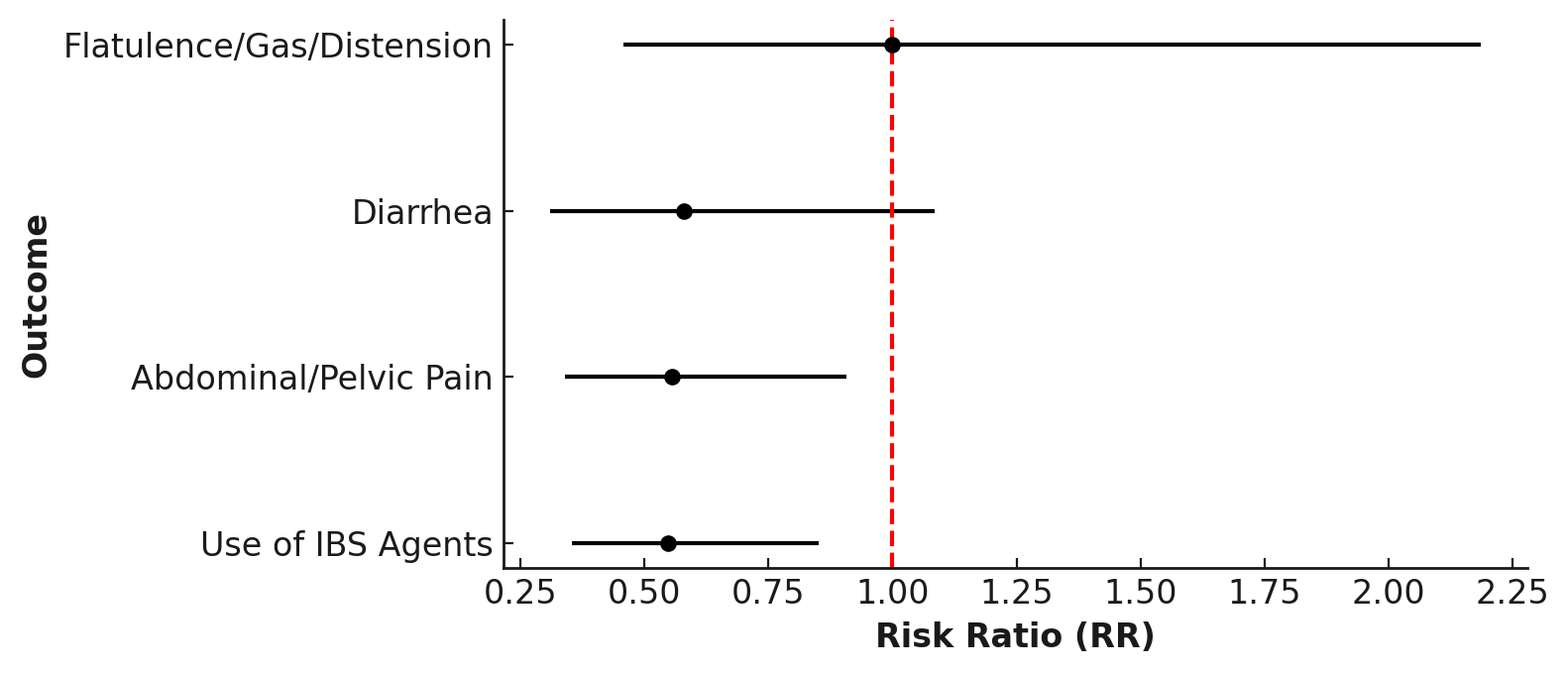Sunday Poster Session
Category: Functional Bowel Disease
P0794 - GLP-1 Receptor Agonist Use for Reducing Symptom Burden and Medication Utilization in Non-Obese Women With IBS-D: A Propensity Matched Retrospective Cohort Study
Sunday, October 26, 2025
3:30 PM - 7:00 PM PDT
Location: Exhibit Hall

Jordan Barnett-Kradjian, DO
Stony Brook Medicine
Stony Brook, NY
Presenting Author(s)
Jordan Barnett-Kradjian, DO1, Kaustav Patra, MD2, Jacky Reny, MD2, Rahul Tripathi, MD1
1Stony Brook Medicine, Stony Brook, NY; 2Stony Brook University Hospital, Port Jefferson Station, NY
Introduction: GLP-1 receptor agonists (GLP-1 RAs) are established therapies for diabetes and weight management. Their potential use in functional gastrointestinal disorders, such as irritable bowel syndrome (IBS) remains poorly defined. Current literature regarding GLP-1 RA therapy for IBS does not adequately stratify weight or IBS subtypes, especially diarrhea-predominant IBS (IBS-D). This study investigates the clinical impact of GLP-1 RA therapy on non-obese, non-diabetic women with IBS-D.
Methods: We conducted a retrospective cohort study using the TriNetX database. Females aged 18-75 with a diagnosis of IBS-D, BMI 20-29, and prior use of IBS medications were included. Patients with obesity, diabetes, H. pylori infection, inflammatory bowel disease, or celiac disease were excluded. Two cohorts were identified: those prescribed GLP-1 RAs and those prescribed non-GLP IBS medications such as alosetron, eluxadoline, or loperamide. Outcomes including abdominal pain, diarrhea, flatulence, gas, abdominal distension, and IBS medication use were evaluated over a 2-year window following the first documented prescription for either group. Propensity score matching (1:1) was performed based on age, BMI, and associated conditions including small intestinal bacterial overgrowth, resulting in 49 patients per group. Risk was reported as risk ratios (RR) with 95% confidence intervals (CIs) and a p-value < 0.05 was considered statistically significant.
Results: GLP-1 RA users had a significantly lower risk for abdominal pain (RR 0.56, CI 0.34-0.91, p= 0.014), and IBS agent use (RR 0.55, CI 0.35-0.85, p= 0.005). GLP-1 users had a lower risk for diarrhea (22% vs. 38%, RR 0.58, CI 0.31-1.08, p=0.08). No significant differences were observed for flatulence, gas or abdominal distension.
Discussion: GLP-1 RA use was associated with decreased abdominal pain and less use of IBS-specific medications in non-obese, non-diabetic women with IBS-D. Although not significant, women using GLP-1 RAs also had lower risk for diarrhea, warranting future investigation with larger populations. These findings suggest a potential role for GLP-1 RAs in IBS symptom modulation independent of metabolic effects, warranting further prospective studies.

Figure: Risk of outcomes for women with IBS-D after initiating GLP-1RA therapy
Disclosures:
Jordan Barnett-Kradjian indicated no relevant financial relationships.
Kaustav Patra indicated no relevant financial relationships.
Jacky Reny indicated no relevant financial relationships.
Rahul Tripathi indicated no relevant financial relationships.
Jordan Barnett-Kradjian, DO1, Kaustav Patra, MD2, Jacky Reny, MD2, Rahul Tripathi, MD1. P0794 - GLP-1 Receptor Agonist Use for Reducing Symptom Burden and Medication Utilization in Non-Obese Women With IBS-D: A Propensity Matched Retrospective Cohort Study, ACG 2025 Annual Scientific Meeting Abstracts. Phoenix, AZ: American College of Gastroenterology.
1Stony Brook Medicine, Stony Brook, NY; 2Stony Brook University Hospital, Port Jefferson Station, NY
Introduction: GLP-1 receptor agonists (GLP-1 RAs) are established therapies for diabetes and weight management. Their potential use in functional gastrointestinal disorders, such as irritable bowel syndrome (IBS) remains poorly defined. Current literature regarding GLP-1 RA therapy for IBS does not adequately stratify weight or IBS subtypes, especially diarrhea-predominant IBS (IBS-D). This study investigates the clinical impact of GLP-1 RA therapy on non-obese, non-diabetic women with IBS-D.
Methods: We conducted a retrospective cohort study using the TriNetX database. Females aged 18-75 with a diagnosis of IBS-D, BMI 20-29, and prior use of IBS medications were included. Patients with obesity, diabetes, H. pylori infection, inflammatory bowel disease, or celiac disease were excluded. Two cohorts were identified: those prescribed GLP-1 RAs and those prescribed non-GLP IBS medications such as alosetron, eluxadoline, or loperamide. Outcomes including abdominal pain, diarrhea, flatulence, gas, abdominal distension, and IBS medication use were evaluated over a 2-year window following the first documented prescription for either group. Propensity score matching (1:1) was performed based on age, BMI, and associated conditions including small intestinal bacterial overgrowth, resulting in 49 patients per group. Risk was reported as risk ratios (RR) with 95% confidence intervals (CIs) and a p-value < 0.05 was considered statistically significant.
Results: GLP-1 RA users had a significantly lower risk for abdominal pain (RR 0.56, CI 0.34-0.91, p= 0.014), and IBS agent use (RR 0.55, CI 0.35-0.85, p= 0.005). GLP-1 users had a lower risk for diarrhea (22% vs. 38%, RR 0.58, CI 0.31-1.08, p=0.08). No significant differences were observed for flatulence, gas or abdominal distension.
Discussion: GLP-1 RA use was associated with decreased abdominal pain and less use of IBS-specific medications in non-obese, non-diabetic women with IBS-D. Although not significant, women using GLP-1 RAs also had lower risk for diarrhea, warranting future investigation with larger populations. These findings suggest a potential role for GLP-1 RAs in IBS symptom modulation independent of metabolic effects, warranting further prospective studies.

Figure: Risk of outcomes for women with IBS-D after initiating GLP-1RA therapy
Disclosures:
Jordan Barnett-Kradjian indicated no relevant financial relationships.
Kaustav Patra indicated no relevant financial relationships.
Jacky Reny indicated no relevant financial relationships.
Rahul Tripathi indicated no relevant financial relationships.
Jordan Barnett-Kradjian, DO1, Kaustav Patra, MD2, Jacky Reny, MD2, Rahul Tripathi, MD1. P0794 - GLP-1 Receptor Agonist Use for Reducing Symptom Burden and Medication Utilization in Non-Obese Women With IBS-D: A Propensity Matched Retrospective Cohort Study, ACG 2025 Annual Scientific Meeting Abstracts. Phoenix, AZ: American College of Gastroenterology.
